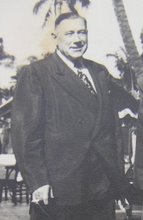The article leaves out much detail, principally Forrest Mars, the man that made Huzenlaub's journey to America possible.
When Time references Huzenlaub as a German, note how they immediately state, "now a naturalized British citizen". This reference is made because the United States was at war with Germany at the time. The Time Magazine editor wanted to point out that Huzenlaub was a British citizen during the war.
At the time, Huzenlaub was new to America and his primary acquaintance was Forrest Mars. He was not schooled in the processes of marketing and public relations and was not concerned over who received credit for his work. Rather, he wanted to see the world eat more nutritiously and worked vigorously to make sure that the Huzenlaub Process delivered this goal. He could not have achieved this global reach without the support of Forrest Mars.

RICHER RICE
Time Magazine Archives
The milling of white rice has been a notoriously paradoxical operation: most of the food value is stripped off and thrown away before the grain is considered fit for human consumption. A new process has now been developed which avoids this wasteful procedure. Already supplying good, rich white rice to the U.S. armed forces, the process may revolutionize rice milling.
Its U.S. sponsor is a Houston food broker named Gordon L. Harwell. A born pot-watcher, Harwell used to sit up late nights with a pressure cooker and a potful of paddy (rice in the husk) trying to cook up an improvement on conventional milling methods. In orthodox rice milling, machines first remove the husk (containing vitamin Bi), then the germ and several coats of bran (rich in fat, minerals and vitamin B complex), finally give forth a polished white kernel which has lost most of the vitamins and minerals in the original rough grain. (The husks are burned; the bran fed to animals.)
Harwell wanted white rice and all the vitamins too. Brown rice (the stage before the bran and germ are removed) is both rich and edible, but it has never been as popular as white rice because it 1) looks less attractive and 2) keeps less well (the oil it contains becomes rancid). Harwell hunted for a process that would somehow transfer the valuable food elements from the outer coatings to the white kernel, but his pressure cooker experiments were failures.
Then one day a German biochemist named Erich Gustav Huzenlaub (now a naturalized British citizen) marched into Harwell's Houston office with the magic formula. Today, the Harwell plant at Houston produces 1,200 barrels of Huzenlaub Rice (called "converted rice") a day, all of it sold to the Army & Navy. In the new process the rough rice is soaked in warm water, undergoes a vacuum treatment, then is put under pressure which transfers the soluble vitamins and minerals from the husks and bran coatings to the kernel. Next a vacuum dryer seals the vitamins in the kernel; then the rice is husked and polished in the usual way.
Since rice is the world's No. 1 grain (in the number of people it feeds), the Huzenlaub Process may well prove to be one of the most important food discoveries in years. The U.S. rice-milling industry, still loath to accept it, has denied Harwell's firm membership in the Rice Millers' Association, claims that the new process is no better than several others by which milled rice is impregnated with vitamins. But millers in 36 countries around the world are now licensed to use the Huzenlaub Process. Only country turned down so far: Japan. - June 28, 1943

No comments:
Post a Comment